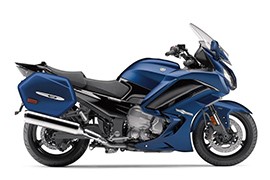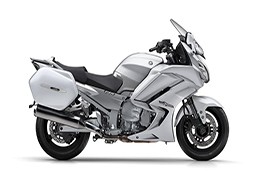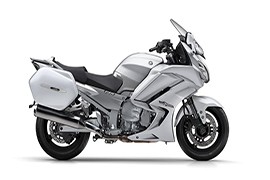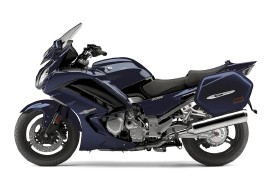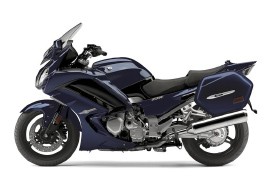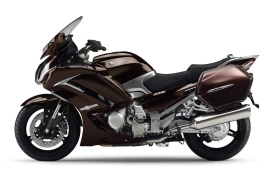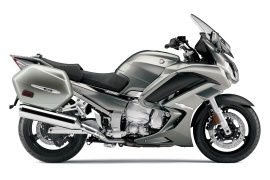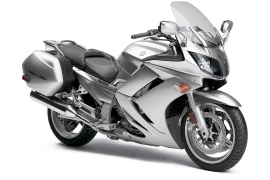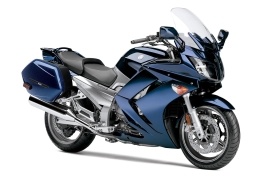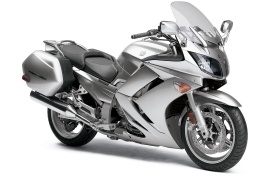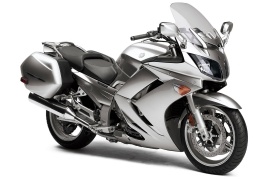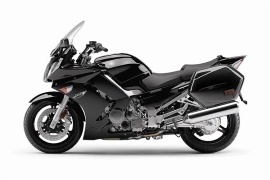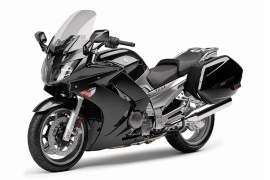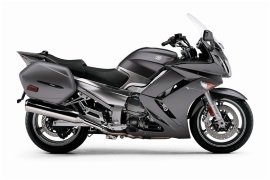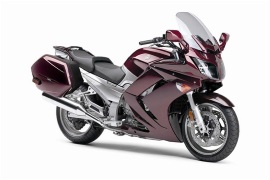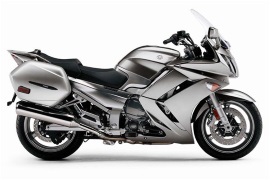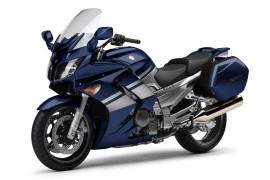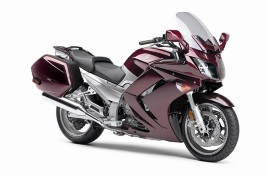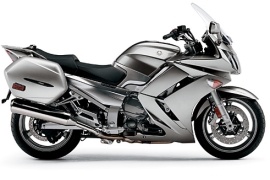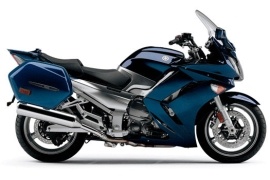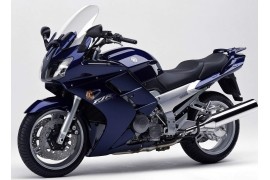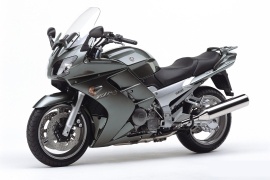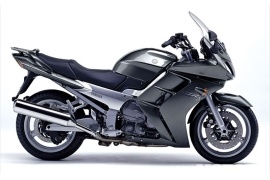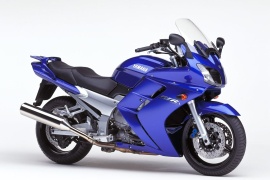YAMAHA FJR 1300 Models/Series Timeline, Specifications & Photos
First production year: 2001
For 2018, the Japanese motorcycle manufacturer launched the Yamaha FJR 1300ES, a sport-touring motorcycle that featured a long list of industry-leading features such as cruise control, electronic suspension, and LED cornering headlights that provided the ultimate sport touring experience.
The advanced suspension offered the performance that suited both the road surface and load with four main settings and three damping settings, which resulted in the best possible riding quality in various road conditions.
The bike featured quick-release luggage mounts for fast removal of the 30-liter color-matched hard saddlebags and a small item storage compartment located in the upper left side of the fairing that contained a 12-volt DC outlet for various accessories.
The 2018 Yamaha FJR 1300ES was brought to life by a lightweight and compact engine that provided massive power and torque with muscular acceleration across the rpm range and a compact six-speed manual transmission designed for smooth and quiet running with a long sixth gear perfect for a relaxed highway riding.
The FJR 1300ES was the first Yamaha motorcycle that featured Yamaha's advanced LED lean-angle sensitive lighting system that offered great visibility through corners with great elimination and improved low-light vision.
In the performance department, the 2018 Yamaha FJR 1300ES had its heartbeat set by a 1,298cc four-stroke four-cylinder liquid-cooled engine that delivered an output power of 146 hp with a peak at 8,000 rpm and 138 Nm (102 lb-ft) of torque available at 7,000 rpm.
In 2017, Yamaha launched the FJR 1300AS, a highly advanced sport touring motorcycle that featured one option, which set it apart from its siblings. Among other features shared between the models, the AS version packed the electronic clutch-less gear shifting system that allowed the rider to change gears with its left foot or from the handlebar without using the clutch lever.
In the technical department, the AS model featured the same options as its siblings, such as the Yamaha Chip Controlled Throttle (YCC-T) that provided great throttle response and controllability and Yamaha D-MODE that worked in tandem with the (YCC-T) system that and offered two riding modes.
The model offered great handling and ergonomics with its aluminum twin-spar diamond-type frame that used the engine as a stressed member and a fully removable aluminum rear subframe that offered easier access to the rear shock absorber for maintenance.
As for power, the 2017 Yamaha FJR 1300AS had its heartbeat set by a 1,298cc four-stroke four-cylinder liquid-cooled engine that delivered an output power of 146 hp with a peak at 8,000 rpm and 138 Nm (102 lb-ft) of torque available at 7,000 rpm.
The 2017 Yamaha FJR 1300AS packed both front and rear electronically-adjustable suspension, while the braking performance was handled by two 320 mm discs with four-piston calipers on the front wheel and a 282 mm disc with a dual-piston caliper on the rear wheel.
For 2017, Yamaha launched the FJR 1300AE, a sport touring motorcycle that featured electronically-adjustable suspension both front and rear with an upside-down fork on the front and a new six-speed transmission with the latest A&S clutch that offered fast acceleration, a more relaxed high-speed cruising, and smoother downshifting.
As for the electronic tweaks and tricks, the bike featured the Yamaha Chip Controlled Throttle (YCC-T) that provided great throttle response and controllability and Yamaha D-MODE that worked in tandem with the (YCC-T) system that and offered two riding modes.
The S mode unlocked the full engine performance and power, while the T mode slowed the throttle response for situations that required lower power characteristics, such as slippery and wet conditions but also worked great for a more relaxed touring riding while reducing fuel consumption.
Both front and rear brakes featured the latest ABS and UBS technology and offered excellent control under wet and slippery conditions with its two 320 mm discs squeezed by a couple of four-piston calipers on the front and a 282 mm disc with a two-piston caliper on the rear.
In addition, the bike featured an adjustable handlebar, adjustable rider seat height, a stylish upper fairing that provided great aerodynamics with excellent wind and weather protection, and optimized airflow management for more rider comfort.
In the performance department, the 2017 Yamaha FJR 1300AE took its thrust from a 1,298cc four-stroke four-cylinder liquid-cooled engine that delivered an output power of 146 hp with a peak at 8,000 rpm and 138 Nm (102 lb-ft) of torque available at 7,000 rpm.
The FJR 1300 was a sport-touring motorcycle that debuted in 2001 in the European market and in 2002 in the American market. The bike featured a powerful 1,298cc engine that delivered massive amounts of power and torque and a chassis designed to offer great handling and ergonomics.
In 2016, the Japanese motorcycle manufacturer released the FJR 1300A, a bike that for the past decade, offered riders the opportunity to experience supersport-level performance and outstanding comfort.
The sport-touring motorcycle was designed to cover serious distances in record time with its 25-liter fuel tank, aerodynamic fairing, adjustable windscreen, adjustable riding position, and cruise control and made use of its big engine and six-speed gearbox and delivered dynamic acceleration and good high-speed cruising performance.
The bike featured an aluminum twin-spar diamond-type frame that used the engine as a stressed member and a fully removable aluminum rear subframe that offered easier access to the rear shock absorber for maintenance.
In the performance department, the 2016 Yamaha FJR 1300A featured a fuel-injected engine with lightweight forged pistons that provided fast engine response and outstanding low-mid power and torque with a red line at 9,000 rpm.
As for the power figures, the 1,298cc four-stroke four-cylinder liquid-cooled engine delivered an output power of 146 hp with a peak at 8,000 rpm and 138Nm (102 lb-ft) of torque available at 7,000 rpm.
In 2017, Yamaha launched the FJR 1300ES, a sport-touring motorcycle that featured a compact and lightweight 1,298cc engine with massive power and torque delivery and muscular acceleration across the rpm range.
The 2017 model received several upgrades, such as an electronically adjustable suspension with an upside-down fork on the front that offered a superior ride and a six-speed manual transmission that gave faster accelerations and a more relaxed high-speed cruising riding.
It was assembled on the same aluminum twin-spar diamond-type frame used by its predecessors and used the engine as a stressed member of the chassis for great rigidity and sharp, accurate handling. Also, the bike packed a fully removable aluminum rear subframe that provided easier access to maintenance of the rear shock absorber and a lightweight cast aluminum swingarm with the integrated shaft drive for less weight.
In the power department, the 2017 Yamaha FJR 1300ES was brought to life by the same 1,298cc engine of its predecessors and delivered massive torque across the rpm range and fast acceleration with a red line painted at 9,000 rpm.
As for the power figures, the four-stroke four-cylinder liquid-cooled engine delivered an output power of 146 hp at 8,000 rpm and 138 Nm (102 lb-ft) of torque with a peak at 7,000 rpm.
For suspension, the model packed a 48 mm electronically adjustable upside-down telescopic fork on the front and an electronically adjustable single shock absorber on the rear, while the braking power was achieved by two 320 mm discs with four-piston calipers on the front and a 282 mm disc with a two-piston caliper on the rear.
In 2014, Yamaha released the FJR1300AS, one of the most incredible touring machines in the world. The 2014 machine came equipped with an electronic clutchless gear shift system that allowed the rider to change gears with the left foot or thumb without using the clutch lever.
The bike retained the potent powerplant, fitted with the Yamaha Chip Controlled Throttle (YCC-T), offering smooth and sporty power delivery. In addition, the engine provided high torque output with excellent and strong acceleration in all gears and top-end power, covering massive distances in less time.
Also, the 2014 Yamaha FJR1300AS came equipped with fully-adjustable ergonomics, enhancing its comfort. The bike was fitted with a seat and an adjustable handlebar, and for better wind and weather protection, it featured an adjustable windscreen.
The 2014 machine packed many advanced electronic control systems, like the Traction Control System (TCS) and cruise control, allowing the rider to choose between a relaxed or a sporty riding experience. The electronically adjustable suspension offered quick and easy chassis tuning.
In the performance department, a 1,298cc liquid-cooled four-stroke four-cylinder engine boasted 145 hp with a peak at 8,500 rpm and 125 Nm (92 lb-ft) torque with maximum strength available at 6,000 rpm.
In the braking department, the massive machine came from the factory with three-spoke lightweight aluminum wheels. The front wheel was fitted with four-piston calipers and two 320 mm discs offering strong stopping power, and the rear wheel had a dual-piston caliper with a 283 mm disc.
In 2001, the Japanese motorcycle maker Yamaha launched the FJR1300, a sport touring machine that proved to be one of the world's most significant touring motorcycles. In 2001 the bike was introduced to the European market, while in 2002, it was introduced in the United States with the 2003 model year designation.
In 2004, the United States model was available in two versions, the non-ABS model featuring anodized blue brake calipers and the ABS version fitted with silver brake calipers. In addition, the bike also featured an upgraded suspension, a fairing pocket for small items, and larger 320 mm discs on the front wheel.
In 2013, Yamaha launched the FJR1300A, a powerful and comfortable machine that received various electronic upgrades, suspension and chassis modifications, and styling upgrades. The bike retained the powerful four-cylinder engine and was fitted with Yamaha Chip Controlled Throttle (YCC-T), Traction Control (TCS), and three riding mods, such as D-Mode, Sport, and Touring.
In the engine department, the 2013 Yamaha FJR1300A packed under its clothes a 1,298cc four-stroke four-cylinder liquid-cooled unit, sending to the rear wheel an output power of 145 hp with peak power at 8,500 rpm and 125 Nm (92 lb-ft) torque at 6,000 rpm.
The bodywork as well received some modifications, including revision for a more modern look, with a revised upper cowl, side panels, and new LED turn signals and position lights. Also, the instrument panel was redesigned, offering a three-part reading panel.
In addition, the touring machine came with several comfort adjustments, including a two-position adjustable rider seat, an adjustable handlebar, and an adjustable windscreen operated by a button.
The FJR 1300 was a powerful sport-touring motorcycle that featured the most advanced technology gained from Yamaha's range of supersport motorcycles, and their performance was topped by great handling and ergonomics.
In 2013, Yamaha released the FJR 1300A, a revised motorcycle that featured a host of electronic, suspensions, and styling upgrades but retained its original 1,298cc engine. For 2013, the bike came with Yamaha Chip Controlled Throttle (YCC-T), Traction Control (TCS), and D-MODE, features that worked in tandem with the new Cruise Control system and offered a more comfortable ride.
Some other upgrades were found in the bodywork, which featured a more modern look with its upper cowl, side panels, the new LED front turn signals, position lights, and also its redesigned instrumentation panel.
In addition, the bike featured some comfort adjustments, such as the two-way adjustable rider seat, the three-position adjustable handlebar, and a tall windshield that was adjustable at just a push of a button.
As for performance, the 2013 Yamaha FJR 1300A was powered by the same engine as its predecessors, such as the powerful 1,298cc four-stroke four-cylinder liquid-cooled engine that delivered an output power of 145 hp at 8,500 rpm and 125 Nm (99 lb-ft) of torque with a peak at 6,000 rpm.
With a dry weight of 264 kg (582 lbs) and set in motion by a five-speed manual transmission with a shaft drive, the bike featured a top speed of 245 kph (152 mph).
In 2012, the Japanese motorcycle manufacturer released the Yamaha FJR 1300, a flagship sport-touring machine in Yamaha's line-up that offered the perfect mix of track-derived performance, outstanding handling, and great comfort for both rider and passenger.
The FJR 1300 was an advanced tourer motorcycle that offered great ergonomics with its adjustable windshield that provided excellent weather protection, adjustable side panels that allowed the rider to redirect the airflow, and the perfectly tuned chassis that provided outstanding handling performance.
The bike featured a lightweight and rigid cast aluminum twin-spar diamond-type frame with a fully removable aluminum rear subframe that offered easier access for maintenance to the rear shock absorber and a lightweight aluminum swingarm that incorporated the shaft drive on its left side for a reduced weight and great handling and suspension performance.
As for suspension, the bike packed a fully adjustable 48 mm cartridge-style fork on the front with 135 mm of wheel travel and an adjustable link monocross rear suspension with 125 mm of wheel travel.
In the performance department, the 2012 Yamaha FJR 1300 model took its thrust from a 1,298cc four-stroke four-cylinder liquid-cooled engine that featured an advanced fuel injection system and lightweight forged pistons for fast engine response.
As for the power figures, the bike delivered an output power of 145 hp with a peak at 8,500 rpm and 125 Nm (99 lb-ft) of torque available at 6,000 rpm.
In 2011, Yamaha released the FJR 1300A, one of the elite sport-touring machines of the modern era that carried on the claimed character of its predecessors, with massive power and torque available on tap and incredible comfort and ergonomics.
The bike featured a smart air management system that kept the rider cool at any time and provided great weather protection with its electronically adjustable windshield and adjustable side panels that allowed the rider to redirect airflow.
The bike came with a lightweight and rigid cast aluminum twin-spar diamond-type frame, a fully removable aluminum rear subframe that provided easier access to the rear shock absorber for maintenance purposes, and a lightweight cast aluminum swingarm that incorporated the shaft drive on its left side for reduced weight and great handling and suspension performance.
For suspension, the bike packed a fully adjustable 48 mm cartridge-style fork that offered 135 mm of wheel travel on the front and an adjustable link monocross suspension on the rear that offered 125 mm of wheel travel.
The 2011 Yamaha FJR 1300A was powered by a 1,298cc engine that featured an advanced fuel injection system and lightweight forged pistons that provided fast engine response and delivered massive amounts of power and torque.
With a 1,298cc displacement, the four-stroke four-cylinder liquid-cooled engine delivered an output power of 145 hp with a peak at 8,500 rpm and 125 Nm (99 lb-ft) of torque available at 6,000 rpm.
One of the most iconic sport-touting machines made by Yamaha was the FJR 1300, a bike that featured the latest technologies and offered massive power and comfort, with its compact, lightweight engine mounted in a lightweight chassis and its transmission that delivered smooth performance.
In 2010, the Japanese motorcycle manufacturer released the Yamaha FJR 1300A, a bike that combined the performance of a supersport machine with the advanced capabilities of a touring motorcycle and offered massive power and torque with great handling performance.
The FJR 1300A featured an air management system that kept the rider cool at any time with its electronically adjustable windshield, a central vent under the instrument panel that directed cool air to the rider and also reduced negative pressure, and the side fairing panels that were adjustable and allowed the rider to redirect airflow.
In the performance department, the 2010 Yamaha FJR 1300A had at its core a compact and lightweight engine used as a fully stressed member of the chassis, which allowed a lightweight frame design and featured an advanced fuel injection system that fed some lightweight forged pistons that delivered great engine performance.
As for the power figures, the 1,298cc four-stroke four-cylinder liquid-cooled engine delivered an output power of 145 hp with a peak at 8,500 rpm and 125 Nm (99 lb-ft) of torque available at 6,000 rpm.
In 2009, the Japanese motorcycle manufacturer released the Yamaha FJR 1300A, one of the most iconic machines in history that packed superbike performance with first-class comfort thanks to its top-end technologies.
The FJR 1300A featured lots of ponies in a lightweight aluminum frame, excellent ergonomics with its aerodynamic fairing that offered great wind and weather protection, an electrically adjustable windshield, and an air management system that kept the rider cool.
For power performance, the model packed a 1,298cc engine that delivered massive power and torque over a wide rpm range with a red line at 9,000 rpm. Also, the engine featured state-of-the-art technology like the legendary R1 machine, such as a slant block design, stacked "Tri-Axis" transmission, fuel injection, and so on.
As for the power figures, the 2009 Yamaha FJR 1300A took its thrust from a 1,298cc four-stroke four-cylinder liquid-cooled engine that featured an advanced fuel injection system and lightweight forged pistons for outstanding engine response, which delivered an output power of 145 hp at 8,500 rpm and 125 Nm (99 lb-ft) of torque at 6,000 rpm.
The smooth ride was achieved by a fully adjustable 48 mm upside-down telescopic fork on the front and a preload and rebound adjustable single shock absorber on the rear, while the braking performance was handled by two 320 mm discs with four-piston calipers on the front and a 283 mm disc with a single-piston caliper on the rear.
The Yamaha FJR1300 was a sport-touring motorcycle characterized as one of the world's most significant touring motorcycles. In addition to the standard machine, Yamaha added the AE designation to the 2008 FJR1300AE machine, making it even more enjoyable.
Yamaha released the 2009 FJR1300AE with several changes, including a new ABS braking system supplier, a revised windscreen for better wind and weather protection, and modifications to the transmission and clutch, offering even smoother gear changes.
The 2009 model was built on a lightweight, rigid diamond-type aluminum frame designed for sharp handling, with a 48 mm telescopic, upside-down fork with preload, rebound, and compression adjustability handling the bike's front suspension. A link-type single shock absorber with rebound and preload adjustability took care of the rear-end suspension.
The machine was dressed in aerodynamic bodywork with excellent wind and weather protection and a revised air management system that reduced the amount of warm air blown to the rider. In addition, the bike featured air vents located on the front cowl that redirected cool air into the cockpit area.
The 2009 Yamaha FJR1300AE rolled on three-spoke aluminum wheels with four-piston calipers and two 320 mm discs on the front, providing strong stopping power. The rear wheel was fitted with a dual-piston caliper and a 283 mm disc, offering strong braking performance.
In the power department, the massive touring machine came equipped with a 1,298cc four-stroke four-cylinder liquid-cooled engine boasting 145 hp at 8,500 rpm and 125 Nm (92 lb-ft) torque at 6,000 rpm. The engine was paired with a five-speed Yamaha Chip Controlled Shift (YCC-S) transmission and a final shaft drive, pushing the motorcycle to 245 kph (152 mph).
The Yamaha FJR 1300 was one of the world's greatest sport-touring machines, but in 2008, with the addition of the "AE" designation, the FJR 1300AE was born as a more interesting motorcycle.
The 2008 Yamaha FJR 1300AE came with several changes, such as a new supplier for the ABS system, a revised windshield, and changes to the transmission and auto clutch system that delivered even smoother shiftings.
The bike featured a lightweight and rigid cast aluminum twin-spar diamond-type frame designed to deliver sharp handling, with a fully removable aluminum rear subframe that reduced the overall weight and allowed easy access to the rear shock absorbers for maintenance.
For suspension, the bike packed a fully adjustable 48 mm cartridge-style fork on the front that offered 135 mm of wheel travel and an adjustable link monocross suspension on the rear that provided 125 mm of wheel travel and the possibility to choose between solo and two-up preload settings.
Dressed in aerodynamic bodywork, the bike offered excellent wind and weather protection and a revised air management system, which reduced the amount of hot air blown to the rider, while the vents located on the outside of each headlight provided cool air into the cockpit area.
As for power, the 2008 Yamaha FJR 1300AE took its thrust from a 1,298cc four-stroke four-cylinder liquid-cooled engine that delivered an output power of 145 hp with a peak at 8,500 rpm and 125 Nm (99 lb-ft) of torque at 6,000 rpm.
In 2008, the Japanese motorcycle manufacturer launched the Yamaha FJR 1300A, one of the elite sport-touring machines of the industry that delivered massive amounts of power and torque matched by outstanding comfort.
The model featured a lightweight and rigid cast aluminum twin-spar frame with a fully detachable aluminum subframe that reduced the overall weight and allowed easier access for maintaining the rear shock absorber.
Also, the chassis was dressed in an aerodynamic full fairing that provided excellent wind and weather protection and an optimized airflow management system that reduced the amount of heat blown to the rider.
For the 2008 model, Yamaha revised the windshield with a new hard coating on its surface for reduced scratches, and the two-piece screed holder was replaced by a one-piece design for reduced weight.
In addition, the model featured more comfortable grips, folding aerodynamic mirrors, a dual-bulb taillight assembly with integrated turn signals for a sleek appearance, front and rear clear turn signal lenses, a small storage compartment under the seat, and a low-maintenance sealed battery.
As for power, the 2008 Yamaha FJR 1300A took its thrust from a 1,298cc four-stroke four-cylinder liquid-cooled engine that delivered an output power of 145 hp at 8,500 rpm and 125 Nm (99 lb-ft) of torque at 6,000 rpm.
In 2007, Yamaha launched the FJR 1300AE, a sport-tourer motorcycle that featured the same updates brought on the 2006 model that enhanced the comfort for the rider and passenger while maintaining the performance characteristics of a sports bike.
Yamaha introduced on the 2007 AE model the electronically controlled clutch system that allowed the rider to change gears without operating the clutch lever removed by the manufacturer and replaced with paddles on the handlebar, also the foot lever remained in the same position, and still functioned as the gear shifter.
In the aesthetic department, the bike featured a new bodywork and an air-management system that provided more comfort for both rider and passenger, with a vent located under the instrument panel that also reduced negative pressure.
Also, the model featured a curved radiator, a longer swingarm that offered better riding and handling characteristics, an adjustable windscreen, a newly designed rear frame with an integrated grab handle, repositioned footpegs for more comfort, and integrated turn signals for a cleaner look.
As for the power performance, the 2007 Yamaha FJR 1300AE featured the same specification as the previous model with a 1,298cc four-stroke four-cylinder liquid-cooled engine that delivered an output power of 145 hp with a peak at 8,500 rpm and 125 Nm (99 lb-ft) of torque available at 6,000 rpm.
The Yamaha FJR1300 was a sport touring motorcycle manufactured by Yamaha, introduced in 2001 for the European market and in the US in 2002 with the 2003 model year designation. The 2003 model was offered without an Anti-Lock Braking System (ABS).
In 2004, in the North American market, Yamaha offered the FJR1300 in two versions. A non-ABS version packed with blue anodized brake calipers and an ABS version equipped with silver brake calipers. In addition, the 2004 models came with an upgraded suspension system and larger 320 mm brake discs on the front.
In 2007, the Yamaha FJR1300 was introduced with minor changes to the Electronic Control Unit (ECU) for dealing with issues related to altitude changes and under various circumstances. In 2008, Yamaha changed the throttle feel, improved low-speed on-off throttle transitions, and changed the ABS braking system supplier.
The 2008 Yamaha FJR1300 came equipped with three-spoke lightweight aluminum wheels fitted with four-piston calipers and two 320 mm discs handling the front stopping power. A dual-piston caliper and a 283 mm disc achieved the rear wheel braking performance.
In the handling department, the massive machine was built on a twin-spar aluminum frame with a 48 mm upside-down telescopic fork with preload, compression, and rebound adjustability, taking care of the front suspension. The rear-end suspension was handled by a link-type shock absorber with preload and rebound adjustability offering excellent handling capabilities.
In the power department, the 2008 Yamaha FJR1300 had fitted under its aerodynamic clothes a 1,298cc transverse four-cylinder four-stroke liquid-cooled powerplant, boasting 145 hp at 8,500 rpm and 125 Nm (92 lb-ft) torque with peak power at 6,000 rpm.
In 2006, Yamaha launched the FJR 1300A, a sports-touring machine with power and torque that matched superbike motorcycles but with long-ride comfort offered for both rider and passenger and plenty of on-board storage topped by multiple technological features that enhanced its overall performance.
For the 2006 model, Yamaha introduced a new, shaper bodywork with an air-management system that offered enhanced comfort, a new curved radiator with Twin-ring cooling fans that kept the engine and cockpit cool, vertically adjustable seats, three-way adjustable handlebar puled-back angle, and an adjustable windshield that improved wind protection and reduced negative pressure.
Also, the big tourer featured a longer swingarm that provided better ride and handling characteristics and a clever braking system with the front brake lever that activated six of the eight front pistons and two rear pistons, while the rear brake pedal activated two rear pistons and the other two from the front for a more balanced braking performance.
In the performance department, the engine came in a lightweight and compact package that delivered massive power and torque with its lightweight forged pistons and advanced fuel injection system that provided a crisp throttle response.
As for the power figures, the 2006 Yamaha FJR 1300A remained unchanged with a power output of 145 hp at 8,500 rpm and 125 Nm (99lb-ft) of torque at 6,000 rpm delivered by a 1,298cc four-stroke four-cylinder liquid-cooled engine.
In 2006, Yamaha released the FJR 1300AE version that introduced several upgrades for enhanced comfort for the rider and passenger while still maintaining its performance characteristics of a sports machine.
First ao all, Yamaha introduced on the 2006 AE model the electronically controlled clutch system that made life easier for the rider with its still manual-operated shifter that didn't require clutch assistance at shifting gears, which resulted in a clutchless handlebar.
The sharper-looking bodywork and air-management system kept the rider much cooler, with a central vent located under the instrument panel that reduced negative pressure and also packed adjustable side panels that allowed the rider to direct the airflow.
In addition, the model featured a new, curved radiator, a longer swingarm that offered better riding and handling characteristics, an adjustable windscreen, a newly designed rear frame with an integrated grab handle, repositioned footpegs for more comfort, a lockable glove compartment, and integrated turn signals for a cleaner look.
In the performance department, the 2006 Yamaha FJR 1300AE remained unchanged with its 1,298cc four-stroke four-cylinder liquid-cooled engine that delivered an output power of 145 hp with a peak at 8,500 rpm and 125 Nm (99 lb-ft) of torque at 6,000 rpm.
The big sport-touring machine, with its electronically controlled clutch system and five-speed transmission, reached a top speed of 245 kph (152 mph).
In 2006, the Japanese motorcycle manufacturer released the Yamaha FJR 1300, a flagship sport-touring machine in Yamaha's line-up that delivered the perfect mix of track-derived nerve, outstanding handling, and great comfort for both rider and passenger.
The long-running FJR 1300 sports tourer came in 2006 with several changes to the bodywork and chassis that enhanced the rider and passenger comfort.
The new fairing allowed more range of movement for the electronically adjustable windscreen with 135 mm vertical adjustment and almost 50 mm forward and backward movement, while the new mid-cowl featured on both sides of the bike offered 30 mm adjustability for managing the air around the rider and passenger.
In addition, the bike also featured larger headlights individually adjustable from inside the fairing, a 12-volt socket in the lockable glove compartment, standard heated grips, adjustable handlebars, and the footpegs that were moved 20 mm down and 40 mm forward for a more relaxed position.
In other departments, the bike remained unchanged such as the engine and transmission, but the swingarm was extended by 40 mm to direct the overall weight on the front wheel, while the ABS, which was previously an option, was offered as a standard feature for the 2006 model.
As for power, the 2006 Yamaha FJR 1300 had its heartbeat set by a 1,298cc four-stroke four-cylinder liquid-cooled engine that provided an output power of 145 hp at 8,500 rpm and 125 Nm (99 lb-ft) of torque at 6,000 rpm.
In 2005, Yamaha launched the FJR 1300, a light, powerful, and technologically advanced motorcycle that combined the agile handling of a sports bike with long-distance comfort with its massive powerplant and aluminum chassis. Also, for those riders that wanted extra peace of mind, the bike was available in an ABS version.
The hollow cast-aluminum frame was very light and rigid, which was the perfect combination for sharp handling that used the engine as a stressed member of the chassis, which allowed a lightweight frame design.
Also, the bike featured an aerodynamic full fairing highlighted by an electrically adjustable windscreen that could be easily raised for better wind protection and lowered for a sportier look just with a press of a button located on the handlebar.
In addition, the model featured a convenient storage pocket for small items located on the front fairing, a standard toolkit under the passenger seat, and saddlebags as standard equipment.
As for power, the 2005 Yamaha FJR 1300 took its thrust from a 1,298cc four-stroke four-cylinder liquid-cooled engine that delivered an output power of 145 hp with a peak at 8,500 rpm and 125 Nm (99 lb-ft) of torque available at 6,000 rpm.
The plush ride was achieved by a Soqi preload, compression, and rebound adjustable telescopic fork on the front and a preload and rebound adjustable single shock absorber on the rear.
In 2004, the Japanese motorcycle manufacturer released the Yamaha FJR 1300, a sport-touring machine that delivered great comfort and massive amounts of power and torque but also brought several changes for the 2004 model.
First of all, the bike was available with or without ABS, which was a safety feature that enhanced the performance of the machine, so both versions received new front brake master cylinders with a one mm bore diameter increase for the non-ABS version and two mm increase for the ABS version, but also 22 mm larger discs on the front.
Another update for the model included the 2003 optional electronically adjustable windshield that came as standard on the 2004 model with a 40mm increase in height and still operated from the thumb button on the handlebar.
Both front and rear suspensions were revised with a 10 percent increase in the spring rate for the front fork and a 15 percent increase in the spring rate for the rear shock absorber and still delivered a plush ride with the suspension firming up as it used more travel.
In addition, the bike also received a storage compartment on the front fairing, front headlight beam adjustment from a hand-turning wheel under the front fairing, and integrated turn signals for a cleaner look.
In the performance department, the bike remained unchanged with the 1,298cc four-stroke four-cylinder liquid-cooled engine that delivered an output power of 145 hp at 8,500 rpm and 125 Nm (99 lb-ft) of torque at 6,000 rpm.
In 2003, Yamaha launched the FJR 1300, a sport-touring machine that packed great comfort with massive power and torque backed up by top-end onboard equipment and lots of superbike-derived technologies.
The 2003 Yamaha FJR 1300 received another title from the Cycle World magazine at its debut in 2003 as the "Best Sport-Toring Bike" and they said, "Combines cruise-ship comfort with a motor that would probably propel an ocean liner at a good clip, all wrapped in a classy-looking silver package."
The 2003 model got a taller adjustable power windshield and storage pocked in the fairing for small items, but it also came with saddlebags as standard equipment, a shaft drive, a thick dual seat, and a 1,298cc engine tuned to deliver low-mid power and torque.
Also, the bike took its thrust from a 1,298cc four-stroke four-cylinder liquid-cooled engine used as a stressed member by the rigid, massive, lightweight aluminum frame and delivered an output power of 145 hp at 8,500 rpm and 125 Nm (99 lb-ft) of torque at 6,000 rpm.
The sport-touring machine was set in motion by a five-speed manual transmission with a shaft drive that spun the rear wheel to a top speed of 249 kph (155 mph).
For braking performance, the bike packed two 298 mm discs with four-piston calipers on the front wheel and a 283 mm disc on the rear wheel squeezed by a two-piston caliper.
In 2002, the Japanese motorcycle manufacturer launched the Yamaha FJR 1300, a motorcycle that might have been one of the benchmarks for sport-touring performance as a big yet slender machine loaded with a powerful engine that delivered low-end torque and sizzling top-end performance with a low-maintenance shaft drive and plenty of touring accessories.
Yamaha claimed that their 2002 FJR 1300 had the chassis performance of a sports bike and the ergonomic characteristics of a long-distance touring machine with a new four valves per cylinder design rather than the five valves per-cylinder Yamaha's trademark design, with the engine used as a stressed member of the chassis, and a one-piece block and crankcase assembly design derived from the R1 model.
The 2002 Yamaha FJR 1300 motorcycle had its heartbeat set by a 1,298cc four-stroke four-cylinder liquid-cooled fuel-injected engine that delivered an output power of 145 hp with a peak at 8,500 rpm and 125 Nm (99 lb-ft) of torque at 6,000 rpm.
For suspension, the big tourer packed a 48 mm Soqi adjustable telescopic fork on the front and an adjustable link-type single shock absorber on the rear.
As for braking performance, the bike stopping power was provided by two 298 mm discs with a couple of four-piston calipers on the front wheel and a 283 mm disc on the rear squeezed by a two-piston caliper.
The FJR 1300 was a sport touring motorcycle made by Yamaha and introduced in the European market in 2001, and in 2002 was introduced in the North American market as a 2003 model that featured a 1,298cc inline four-cylinder engine.
The 2003 model was delivered as a non-ABS version only, while it gained several awards in the sport touring category from various magazines.
In 2004, the North American models came in two versions such as the non-ABS version with traditional blue anodized brake calipers and the ABS version that featured silver calipers along with other changes such as an upgrade to the suspension rates, 22 mm larger front brake discs, and a fairing pocket for perfect for fitting small items.
At the time of its release, the 2001 FJR 1300 model was one of the most powerful and advanced tourers on the market with the characteristics of a sports bike, such as a twin-spar aluminum frame, a powerful fuel-injected engine, and adjustable suspension.
AL that advanced technology was wrapped in a large touring fairing with a comfortable upright seating position, a shaft drive, and hard luggage cases. The bike combined sporting performance with touring convenience.
As for power, the 2001Yamaha FJR 1300 took its thrust from a 1,298cc four-stroke four-cylinder liquid-cooled fuel-injected engine that provided 145 hp at 8,500 rpm and 125 Nm (99 lb-ft) of torque at 6,000 rpm, a power that was converted into speed by a five-speed manual transmission that spun the rear wheel to a top speed of 249 kph (155 mph).
